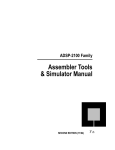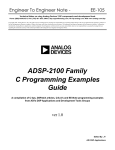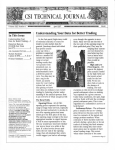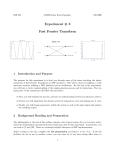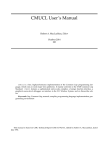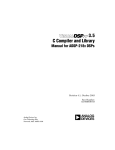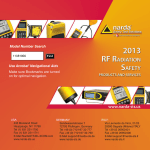Download ADSP-2100 Family C Runtime Library Manual
Transcript
ADSP-2100 Family C Runtime Library Manual a ADSP-2100 Family C Runtime Library Manual © 1994 Analog Devices, Inc. ALL RIGHTS RESERVED PRODUCT AND DOCUMENTATION NOTICE: Analog Devices reserves the right to change this product and its documentation without prior notice. Information furnished by Analog Devices is believed to be accurate and reliable. However, no responsibility is assumed by Analog Devices for its use, nor for any infringement of patents, or other rights of third parties which may result from its use. No license is granted by implication or otherwise under the patent rights of Analog Devices. PRINTED IN U.S.A. Printing History SECOND EDITION 11/94 For marketing information or Applications Engineering assistance, contact your local Analog Devices sales office or authorized distributor. If you have suggestions for how the ADSP-2100 Family development tools or documentation can better serve your needs, or you need Applications Engineering assistance from Analog Devices, please contact: Analog Devices, Inc. DSP Applications Engineering One Technology Way Norwood, MA 02062-9106 Tel: (617) 461-3672 Fax: (617) 461-3010 e-mail: [email protected] Or log in to the DSP Bulletin Board System: Telephone number (617) 461-4258 300, 1200, 2400, 9600 baud, no parity, 8 bits data, 1 stop bit For additional marketing information, call (617) 461-3881 in Norwood MA, USA. Literature ADSP-2100 FAMILY MANUALS ADSP-2100 Family User’s Manual (Prentice Hall) Complete description of processor architectures and system interfaces. ADSP-2100 Family Assembler Tools & Simulator Manual ADSP-2100 Family C Tools Manual ADSP-2100 Family C Runtime Library Manual Programmer’s references. ADSP-2100 Family EZ Tools Manual User’s manuals for in-circuit emulators and demonstration boards. APPLICATIONS INFORMATION Digital Signal Processing Applications Using the ADSP-2100 Family, Volume 1 (Prentice Hall) Topics include arithmetic, filters, FFTs, linear predictive coding, modem algorithms, graphics, pulse-code modulation, multirate filters, DTMF, multiprocessing, host interface and sonar. Digital Signal Processing Applications Using the ADSP-2100 Family, Volume 2 (Prentice Hall) Topics include modems, linear predictive coding, GSM codec, sub-band ADPCM, speech recognition, discrete cosine transform, digital tone detection, digital control system design, IIR biquad filters, software uart and hardware interfacing. SPECIFICATION INFORMATION ADSP-2100/ADSP2100A Data Sheet ADSP-21xx Data Sheet ADSP-21msp50A/55A/56A Data Sheet ADSP-21msp58/59 Preliminary Data Sheet ADSP-2171/72/73 Data Sheet ADSP-2181 Preliminary Data Sheet Contents CHAPTER 1 1.1 1.2 1.2.1 1.2.2 LIBRARY STRUCTURE ANSI RUNTIME ENVIRONMENT MACROS & DEFINITIONS ...................... 3–1 ANSI STANDARD FUNCTIONS .................................................................... 3–1 CHAPTER 4 4.1 4.2 4.3 4.4 4.5 USING LIBRARY FUNCTIONS CALLING FUNCTIONS .................................................................................. 2–1 Header Files .......................................................................................... 2–1 Built-In Functions ................................................................................... 2–1 LIBRARY DIRECTORY .................................................................................. 2–2 LIBRARY SOURCE CODE ............................................................................ 2–2 CHAPTER 3 3.1 3.2 INTRODUCTION OVERVIEW .................................................................................................... 1–1 DOCUMENTATION ........................................................................................ 1–1 Notation Conventions ............................................................................ 1–1 Reference Format .................................................................................. 1–2 CHAPTER 2 2.1 2.1.1 2.1.2 2.2 2.3 2 HEADER FILES OVERVIEW .................................................................................................... 4–1 float.h – FLOATING POINT ............................................................................ 4–1 filters.h – DSP FILTERS ................................................................................. 4–1 math.h – MATHEMATICS .............................................................................. 4–1 signal.h – SIGNAL & INTERRUPT HANDLING ............................................. 4–2 v2 – 1 3 Contents LIBRARY FUNCTIONS & DESCRIPTIONS abs acos asin atan atan2 ceil cos cosh demean_buffer exp fabs fftN fir floor fmod frexp ifftN iir interrupt isalpha isdigit labs ldexp log log10 memcmp memcpy memset modf pow raise signal sin sinh sqrt strcat strcmp strcpy strlen strncat strncmp 2 – vi2 absolute value ................................................................................... L–1 arc cosine .......................................................................................... L–2 arc sine .............................................................................................. L–3 arc tangent ........................................................................................ L–4 arc tangent of quotient....................................................................... L–5 ceiling ................................................................................................ L–6 cosine ................................................................................................ L–7 hyperbolic cosine ............................................................................... L–8 remove the mean of a data buffer ..................................................... L–9 exponential ...................................................................................... L–11 float absolute value ......................................................................... L–12 N-point complex input fast Fourier transform (FFT) ........................ L–13 finite impulse response (FIR) filter ................................................... L–15 floor ................................................................................................. L–17 floating-point modulus ..................................................................... L–18 separate fraction and exponent ....................................................... L–19 N-point inverse complex input fast Fourier transform (IFFT)........... L–20 infinite impulse response (IIR) filter ................................................. L–23 define interrupt handling .................................................................. L–26 detect alphabetic character ............................................................. L–28 detect decimal digit .......................................................................... L–29 long integer absolute value ............................................................. L–30 multiply by power of 2 ...................................................................... L–31 natural logarithm .............................................................................. L–32 base 10 logarithm ............................................................................ L–33 compare objects .............................................................................. L–34 copy characters from one object to another .................................... L–35 set range of memory to a character ................................................ L–36 separate integral and fractional parts .............................................. L–37 raise to a power ............................................................................... L–38 force a signal ................................................................................... L–39 define signal handling...................................................................... L–41 sine .................................................................................................. L–43 hyperbolic sine ................................................................................ L–44 square root ...................................................................................... L–45 concatenate strings ......................................................................... L–46 compare strings ............................................................................... L–47 copy from one string to another....................................................... L–48 string length ..................................................................................... L–49 concatenate characters from one string to another ......................... L–50 compare characters in strings ......................................................... L–51 Contents 3 strncpy tan tanh timer_off timer_on timer_set va_arg va_end va_start copy characters from one string to another ..................................... L–52 tangent ............................................................................................ L–53 hyperbolic tangent ........................................................................... L–54 disable ADSP-21XX timer ............................................................... L–55 enable ADSP-21XX timer ................................................................ L–56 initialize ADSP-21XX timer .............................................................. L–57 get next argument in variable list..................................................... L–58 reset variable list pointer ................................................................. L–59 set variable list pointer ..................................................................... L–60 TABLES Table 3.1 Table 3.2 ANSI Standard Runtime Environment Macros & Definitions ................... 3–1 ANSI Standard Functions ........................................................................ 3–1 Table 4.1 C Runtime Library Header Files............................................................... 4–1 vii 2–3 3 Contents 2 –viii4 Introduction 1.1 1 OVERVIEW The C Runtime Library Manual documents a set of C callable functions written in ADSP-2100 Family assembly language. Programs written in C depend on library functions to perform basic operations not provided by the language. These functions include memory allocation, signal processing, and mathematics functions. Use of the library simplifies the software development process. This document describes the current release of the runtime library. Future releases may include more functions. The object files of the library functions may be freely used in systems based on ADSP-2100 Family processors. The algorithms used to implement many of the mathematic functions are taken from the following reference: Cody and Waite. Software Manual For The Elementary Functions. Prentice Hall, 1980. See the current ADSP-2100 Family Development Software Tools release note for function benchmarks. 1.2 1.2.1 DOCUMENTATION Notation Conventions An interval of numbers is indicated by the minimum and maximum, separated by a comma, and enclosed in two square brackets, two parentheses, or one of each. A square bracket indicates that the endpoint is included in the set of numbers; a parenthesis indicates that the endpoint is not included. 1–1 1 Introduction 1.2.2 Reference Format Each function in the library is listed in the following format: Description FUNCTION foof—does nothing Explanation Purpose of the function SYNOPSIS #include <fnord.h> void foof(float x); Required header file and functional prototype DESCRIPTION The foof function... Function specification ERROR CONDITIONS How the function indicates an error Errors returned by the foof... 1–2 EXAMPLE #include <fnord.h> foof(0.0); Typical function usage SEE ALSO foo2, foo3 Related functions Using Library Functions 2.1 2 CALLING FUNCTIONS To use a C library function, call the function by name and give the appropriate arguments. The necessary arguments for each function are specified in the Library Reference section of this volume. You can use the librarian, lib21 , documented in the ADSP-2100 Family Assembler Manual, to build libraries of your own functions. 2.1.1 Header Files If your program calls a library function, you must include the header file containing the function with the #include C preprocessor directive. For the header file to include, see the Synopsis section of the library function you call. Header files contain function prototypes. The compiler uses these prototypes to check that your program calls each function with the correct arguments. 2.1.2 Built-In Functions The C Runtime Library built-in functions are a small set of functions that the compiler immediately recognizes and replaces with inline assembly code instead of a function call. Typically, inline assembly code is faster than an average library routine and it does not incur calling overhead. For example, strcpy(), a function used to copy one string into another space, is recognized by the compiler, which subsequently replaces a call to the C Runtime Library version with an inline version. The following routines are built-in functions for the G21 compiler: abs() fabs() labs() memcpy() memcmp() strcmp() strcpy() strlen() sqrt() If you want to use the C Runtime Library functions of the same name, compile with the -fno-builtin G21 command line switch. 2–1 2 Using Library Functions 2.2 LIBRARY DIRECTORY The linker looks for the C Runtime Library, libda.a , in the subdirectory \21xx\lib of the directory specified in the ADI_DSP operating system environment variable. For example, in an MS-DOS system with the value of ADI_DSP set to c:\adi_dsp , the linker looks for the C Runtime Library in the directory c:\adi_dsp\21xx\lib . 2.3 LIBRARY SOURCE CODE The distribution disks contain source code for the functions and macros in the C Runtime Library. By default, the installation program copies the source code to a subdirectory of the directory where the runtime libraries are kept, named \21xx\lib\src . For example, in an MS-DOS system, the source code for the library is found in the c:\adi_dsp\21xx\lib\src directory. Each function is kept in a separate file. If you do not intend to modify any of the C Runtime Library functions, you can delete this directory and its contents to conserve disk space. The source code is provided so you can customize any particular function for your own needs. Customizing the library requires knowledge of both ADSP-2100 Family assembly language and the C Runtime environment. For information on ADSP-2100 Family assembly language, refer to the ADSP-2100 Family User’s Manual. For information on the C Runtime environment, see the ADSP-2100 Family C Tools Manual. Copy the source code to a file with a different filename before you make any modifications to the source code. Use a new, unique name for your modified function. Note: Analog Devices only supports the runtime library functions as provided. 2–2 Library Structure 3 The C Runtime Library has several categories of functions and macros defined by the ANSI C standard, plus extensions provided by Analog Devices. 3.1 ANSI RUNTIME ENVIRONMENT MACROS & DEFINITIONS The error handling, standard definitions, limits, and floating-point categories do not contain individual functions; they consist of macros and type definitions. Header errno.h stddef.h limits.h float.h Purpose Error Handling Standard Definitions Limits Floating Point Table 3.1 ANSI Standard Runtime Environment Macros & Definitions 3.2 ANSI STANDARD FUNCTIONS Header math.h signal.h stdarg.h ctype.h string.h stdlib.h locale.h assert.h setjump.h stdio.h Purpose Mathematics Signal Handling Variable Arguments Character Handling String Handling Standard Library Localization Diagnostics Non-Local Jumps Input/Output Table 3.2 ANSI Standard Functions Note: The stdio.h file only contains the definition for EOF . The C Runtime Library does not provide standard I/O routines. 3–1 3 Library Structure 3–2 absolute value abs FUNCTION abs—absolute value SYNOPSIS #include <stdlib.h> int abs(int j); DESCRIPTION The abs function returns the absolute value of its int input. Note: abs(INT_MIN) returns INT_MIN . ERROR CONDITIONS The abs function does not return an error condition. EXAMPLE #include <stdlib.h> int i; i = abs(-5); /* i == 5 */ SEE ALSO fabs, labs L–1 3 acos Title arc cosine FUNCTION acos—arc cosine SYNOPSIS #include <math.h> double acos(double); DESCRIPTION The acos function returns the arc cosine of x . The input must be in the range [-1, 1]. The output, in radians, is in the range [0, π ]. The acos function returns a value that is accurate to 20 bits of the mantissa. This accuracy corresponds to a maximum relative error of 2-20 over its input range. ERROR CONDITIONS The acos function indicates a domain error (by setting errno to EDOM ) and returns a zero if the input is not in the range [-1, 1]. EXAMPLE #include <math.h> double y; y = acos(0.0); SEE ALSO cos L–2 /* y = π/2 */ asin 3 Title arc sine FUNCTION asin—arc sine SYNOPSIS #include <math.h> double asin(double); DESCRIPTION The asin function returns the arc sine of the argument. The input must be in the range [-1, 1]. The output, in radians, is in the range [-π/2, π/2]. The asin function returns a value that is accurate to 20 bits of the mantissa. This accuracy corresponds to a maximum relative error of 2-20 over its input range. ERROR CONDITIONS The asin function indicates a domain error (set errno to EDOM ) and returns a zero if the input is not in the range [-1, 1]. EXAMPLE #include <math.h> double y; y = asin(1.0); /* y = π/2 */ SEE ALSO sin L–3 3 atan Title arc tangent FUNCTION atan—arc tangent SYNOPSIS #include <math.h> double atan(double); DESCRIPTION The atan function returns the arc tangent of the argument. The output, in radians, is in the range [-π/2, π/2]. The atan function returns a value that is accurate to 20 bits of the mantissa. This accuracy corresponds to a maximum relative error of 2-20 over its input range. ERROR CONDITIONS The atan function does not return an error condition. EXAMPLE #include <math.h> double y; y = atan(0.0); SEE ALSO atan2, tan L–4 /* y = 0.0 */ atan2 3 Title arc tangent of quotient FUNCTION atan2—arc tangent of quotient SYNOPSIS #include <math.h> double atan2(double x, double y); DESCRIPTION The atan2 function computes the arc tangent of the input value x divided by input value y . The output, in radians, is in the range [-π, π]. The atan2 function returns a value that is accurate to 20 bits of the mantissa. This accuracy corresponds to a maximum relative error of 2-20 over its input range. ERROR CONDITIONS The atan2 function returns a zero and sets errno to EDOM if x=0 and y <> 0. EXAMPLE #include <math.h> double A; A = atan2(0.0/0.5); /* A = 0.0 */ SEE ALSO atan, tan L–5 3 ceil Title ceiling FUNCTION ceil—ceiling SYNOPSIS #include <math.h> double ceil(double); DESCRIPTION The ceil function returns the smallest integral value, expressed as double, that is not less than its input. ERROR CONDITIONS The ceil function does not return an error condition. EXAMPLE #include <math.h> double y; y = ceil(1.05); SEE ALSO floor L–6 /* y = 2.0 */ cos 3 Title cosine FUNCTION cos—cosine SYNOPSIS #include <math.h> double cos(double); DESCRIPTION The cos function returns the cosine of the argument. The input is interpreted as radians; the output is in the range [-1, 1]. The cos function returns a value that is accurate to 20 bits of the mantissa. This accuracy corresponds to a maximum relative error of 2-20 over its input range. Although the cos function accepts input over the entire floatingpoint range, the accuracy of the result decreases significantly for a large input (greater than π12/2). ERROR CONDITIONS The cos function does not return an error condition. EXAMPLE #include <math.h> double y; y = cos(3.14159); /* y = -1.0 */ SEE ALSO acos L–7 3 cosh Title hyperbolic cosine FUNCTION cosh—hyperbolic cosine SYNOPSIS #include <math.h> double cosh(double); DESCRIPTION The cosh function returns the hyperbolic cosine of its argument and a value that is accurate to 20 bits of the mantissa. This accuracy corresponds to a maximum relative error of 2-20 over its input range. ERROR CONDITIONS The cosh function returns HUGE_VAL and sets errno to ERANGE if the input exceeds 212. EXAMPLE #include <math.h> double x,y; y = cosh(x); SEE ALSO sinh L–8 remove the mean of a data buffer Title 3 demean_buffer FUNCTION demean_buffer—remove the mean of a data buffer SYNOPSIS #include <filters.h> int demean_buffer (int *input_buffer, int old_mean, int LENGTH); DESCRIPTION The demean_buffer() routine removes a DC-bias from input signals and the mean from a buffer of data. It can also execute a notch filter on the input based on an adaptive filter. (See Adaptive Signal Processing, Prentice Hall, 1985.) demean_buffer returns the mean of the current buffer as a result. This value should be passed as a parameter to the function on the next call; the first call to demean_buffer should have a 0 for the old_mean value. ERROR CONDITIONS The demean_buffer function does not return error conditions. EXAMPLE #define BUFSIZE 1024 int data_buffer [BUFSIZE]; int data_mean = 0; /* The buffer is filled with data, possibly from a */ /* converter. Remove the mean from the buffer with */ /* this demean function: */ data_demean = demean_buffer(data buffer, L–9 3 demean_buffer Title data_mean, BUFSIZE); /* Or, like this example: */ { int i, temp_mean; temp_mean = 0; for (i=0; i<BUFSIZE; i++) temp_mean += data_buffer[i]; temp_mean /= BUFSIZE; for(i=0; i<BUFSIZE; i++) data_buffer[i] -= temp_mean; } SEE ALSO No references to this function. L – 10 remove the mean of a data buffer exp 3 Title exponential FUNCTION exp—exponential SYNOPSIS #include <math.h> double exp(double); DESCRIPTION The exp function computes the exponential value e to the power of its argument. ERROR CONDITIONS The exp function returns the value HUGE_VAL and stores the value ERANGE in errno when there is an overflow error. In the case of underflow, the exp function returns a zero. EXAMPLE #include <math.h> double y; y = exp(1.0); /* y = 2.71828...*/ SEE ALSO pow, log L – 11 L–1 3 fabs Title float absolute value FUNCTION fabs—float absolute value SYNOPSIS #include <math.h> double fabs(double); DESCRIPTION The fabs function returns the absolute value of the argument. ERROR CONDITIONS The fabs function does not return an error condition. EXAMPLE #include <math.h> double y; y = fabs(-2.3); y = fabs(2.3); SEE ALSO abs, labs L – 12 /* y = 2.3 */ /* y = 2.3 */ N-point complex input fast Fourier transform (FFT) fftN 3 Title FUNCTION fftN—N-point complex input fast Fourier transform (FFT) SYNOPSIS int fft1024(int rl_in[], int im_in[], int rl_out[], int im_out[]); int fft512(int rl_in[], int im_in[], int rl_out[], int im_out[]); int fft256(int rl_in[], int im_in[], int rl_out[], int im_out[]); int fft128(int rl_in[], int im_in[], int rl_out[], int im_out[]); int fft64(int rl_in[], int im_in[], int rl_out[], int im_out[]); int fft32(int rl_in[], int im_in[], int rl_out[], int im_out[]); int fft16(int rl_in[], int im_in[], int rl_out[], int im_out[]); int fft8(int rl_in[], int im_in[], int rl_out[], int im_out[]); L – 13 3 fftN Title N-point complex input fast Fourier transform (FFT) DESCRIPTION These functions are Analog Devices extensions to the ANSI standard. Each of these 8 fftN functions computes the N-point radix-2 fast Fourier transform (FFT) of its integer input (where N is 8, 16, 32, 64, 128, 256, 512, or 1024). There are 8 distinct functions in this set. They all perform the same function with the same type and number of arguments. The only difference between them is the size of the arrays on which they operate. To call a particular function, substitute the number of points for N; for example, fft8(r_inp, i_inp, r_outp, i_outp); not fftN(r_inp, i_inp, r_outp, i_outp); The input to fftN is a integer array of N points. If there are fewer than N actual data points, you must pad the array with zeros to make N samples. Better results occur with less zero padding, however. The input data should be windowed (if necessary) before calling the function because no preprocessing is performed on the data. The functions return a block exponent. ERROR CONDITIONS The fftN functions do not return error conditions. EXAMPLE #include <fft.h> #define N 1024 int i; int real_input[N], imag_input[N], imag_output[N]; int real_output[N]; fft1024 (real_input, imag_input, real_output, imag_output) ; /* Arrays are filled with FFT data */ SEE ALSO ifftN L – 14 finite impulse response (FIR) filter Titlefir 3 FUNCTION fir—finite impulse response (FIR) filter SYNOPSIS #include <filters.h> int fir(int sample, int pm coeffs[], \ int dm state[], int taps); DESCRIPTION This function is an Analog Devices extension to the ANSI standard. The fir() function implements a finite impulse response (FIR) filter defined by the coefficients and delay line that are supplied in the call of fir . The function produces the filtered response of its input data. This FIR filter is structured as a sum of products. The characteristics of the filter (passband, stop band, etc.) are dependent on the coefficient values and the number of taps supplied by the calling program. The integer input to the filter is sample. The integer taps indicates the length of the filter, which is also the length of the array coeffs . The coeffs array holds one FIR filter coefficient per element. The coefficients are stored in reverse order; for example, coeffs[0] holds the (taps-1) coefficient. The coeffs array is located in program memory data space to use the single-cycle dual-memory fetch of the processor. The state array contains a pointer to the delay line as its last element, preceeded by the delay line values. The length of the state array is therefore 1 greater than the number of taps. Each filter has its own state array, which should not be modified by the calling program, only by the fir function. The state array should be initialized to zeros before the fir function is called for the first time. The parameters sample , coeffs[] , and state[] , are all considered to be fractional numbers. The fir() executes fractional multiples that preserve the format of the fractional input. If your application requires a true integer fir() , you should divide the ouput of the filter by two. L – 15 3 firTitle finite impulse response (FIR) filter ERROR CONDITIONS The fir function does not return an error condition. EXAMPLE #include <filters.h> int y; int pm coeffs[10]; /* coeffs array must be */ /* initialized and in */ /* PM memory*/ int state[11]; int i; for (i=0; i < 11; i++) state[i]=0; /* initialize state array */ y = fir(0x1234,coeffs, state, 10); /* y holds the filtered output */ SEE ALSO iir L – 16 floor 3 Title floor FUNCTION floor—floor SYNOPSIS #include <math.h> double floor(double); DESCRIPTION The floor function produces the largest integral value that is not greater than its input. ERROR CONDITIONS The floor function does not return an error condition. EXAMPLE #include <math.h> double y; y = floor(1.25); y = floor(-1.25); /* y = 1.0 */ /* y = -2.0 */ SEE ALSO ceil L – 17 3 fmod Title floating-point modulus FUNCTION fmod—floating-point modulus SYNOPSIS #include <math.h> double fmod(double, double); DESCRIPTION The fmod function computes the floating-point remainder that results from dividing the first argument into the second argument. This value is less than the second argument and has the same sign as the first argument. If the second argument is equal to zero, fmod returns a zero. ERROR CONDITIONS The fmod function does not return an error condition. EXAMPLE #include <math.h> double y; y = fmod(5.0, 2.0); SEE ALSO modf L – 18 /* y = 1.0 */ separate fraction and exponent frexp 3 Title FUNCTION frexp—separate fraction and exponent SYNOPSIS #include <math.h> double frexp(double, int*); DESCRIPTION The frexp function separates a floating-point input into a normalized fraction and a (base 2) exponent. The function returns the first argument, a fraction in the interval [1⁄2, 1), and stores a power of 2 in the integer pointed to by the second argument. If the input is zero, then zeros are stored in both arguments. ERROR CONDITIONS The frexp function does not return an error condition. EXAMPLE #include <math.h> double y; int exponent; y = frexp(2.0, &exponent); /* y=0.5, exponent=2 */ SEE ALSO modf L – 19 3 ifftN Title N-point inverse complex input fast Fourier transform (IFFT) FUNCTION ifftN—N-point inverse complex input fast Fourier transform (IFFT) SYNOPSIS #include <trans.h> int *ifft65536(int dm real_input[], int dm imag_input[], int dm real_output[], int dm imag_output[]); int *ifft32768(int dm real_input[], int dm imag_input[], int dm real_output[], int dm imag_output[]); int *ifft16384(int dm real_input[], int dm imag_input[], int dm real_output[], int dm imag_output[]); int *ifft8192(int dm real_input[], int dm imag_input[], int dm real_output[], int dm imag_output[]); int *ifft4096(int dm real_input[], int dm imag_input[], int dm real_output[], int dm imag_output[]); int *ifft2048(int dm real_input[], int dm imag_input[], int dm real_output[], int dm imag_output[]); int *ifft1024(int dm real_input[], int dm imag_input[], int dm real_output[], int dm imag_output[]); int *ifft512(int dm real_input[], int dm imag_input[], int dm real_output[], int dm imag_output[]); L – 20 N-point inverse complex input fast Fourier transform (IFFT) ifftN 3 Title int *ifft256(int dm real_input[], int dm imag_input[], int dm real_output[], int dm imag_output[]); int *ifft128(int dm real_input[], int dm imag_input[], int dm real_output[], int dm imag_output[]); int *ifft64(int dm real_input[], int dm imag_input[], int dm real_output[], int dm imag_output[]); int *ifft32(int dm real_input[], int dm imag_input[], int dm real_output[], int dm imag_output[]); int *ifft16(int dm real_input[], int dm imag_input[], int dm real_output[], int dm imag_output[]); int *ifft8(int dm real_input[], int dm imag_input[], int dm real_output[], int dm imag_output[]); DESCRIPTION These functions are Analog Devices extensions to the ANSI standard. Each of these 14 ifftN functions computes the N-point radix-2 inverse fast Fourier transform (IFFT) of its integer input (where N is 8, 16, 32, 64, 128, 256, 512, 1024, 2048, 4096, 8192, 16384, 32768 or 65536). L – 21 3 ifftN Title N-point inverse complex input fast Fourier transform (IFFT) There are 14 distinct functions in this set. They all perform the same function with the same type and number of arguments. The only difference between them is the size of the arrays on which they operate. To call a particular function, substitute the number of points for N; for example, ifft8(r_inp, i_inp, r_outp, i_outp); not ifftN(r_inp, i_inp, r_outp, i_outp); The input to ifftN is a integer array of N points. If there are fewer than N actual data points, you must pad the array with zeros to make N samples. Better results occur with less zero padding, however. The input data should be windowed (if necessary) before calling the function because no preprocessing is performed on the data. The functions return a pointer to the real_output array. ERROR CONDITIONS The ifftN functions do not return error conditions. EXAMPLE #include <fft.h> #define N 2048 int i; int real_input[N], imag_input[N], imag_output[N]; int real_output[N]; /* Real input array is filled from a previous fft2048() or other source*/ ifft2048 (real_input, imag_input, real_output, imag_output) ; /* Arrays are filled with FFT data */ SEE ALSO fftN L – 22 infinite impulse response (IIR) filter Titleiir 3 FUNCTION iir—infinite impulse response (IIR) filter SYNOPSIS #include <filters.h> int iir(float sample, int pm a_coeffs[], int pm b_coeffs[], int dm state[], int taps); DESCRIPTION This function is an Analog Devices extension to the ANSI standard. The iir function implements an infinite impulse response (IIR) filter defined by the coefficients and delay line that are supplied in the call of iir . The function produces the filtered response of its input data. The IIR filter implemented in this function is based on the Oppenheim and Schafer Direct Form II. The characteristics of the filter depend on the coefficient values supplied by the calling program. The integer input to the filter is sample . The integer taps indicates the length of the filter, which is the length of the arrays a_coeffs , b_coeffs and delay . The a_coeffs and b_coeffs arrays hold one IIR filter coefficient per element. The coefficients are stored in reverse order; for example, a_coeffs[0] holds the taps-1 (the last coefficient). The state array contains a pointer to the delay line as its last element, preceeded by the delay line values. The length of the state array is therefore 1 greater than the number of taps. Each filter has its own state array, which should not be modified by the calling program, only by the iir function. The state array should be initialized to zeros before the iir function is called for the first time. L – 23 3 iirTitle infinite impulse response (IIR) filter The flow graph below corresponds to the iir() routine as part of the C Runtime Library*: iir ( ) b-coeffs [TAPS] sample output -1 Z b-coeffs [TAPS-1] a-coeffs [TAPS-1] -1 Z b-coeffs [TAPS-2] a-coeffs [TAPS-2] -1 Z b-coeffs [TAPS-3] a-coeffs [TAPS-3] -1 Z b-coeffs[0] a-coeffs [0] The b_coeffs arrays should equal length TAPS+1 The a_coeffs array should equal length TAPS * Adapted from Oppenheim and Schafer, Digital Signal Processing, New Jersey: Prentice Hall, 1975. L – 24 infinite impulse response (IIR) filter Titleiir 3 ERROR CONDITIONS The iir function does not return an error condition. EXAMPLE #include <filters.h> #define TAPS 10 int i; int pm a_coeffs[TAPS], b_coeffs[TAPS]; int in_sample, output, state[TAPS+1]; for (i=0; i < TAPS+1; i++) state[i]=0; /* initialize state array */ output = iir(in_sample, a-coeffs, b-coeffs, state, TAPS); SEE ALSO fir L – 25 3 interrupt Title define interrupt handling FUNCTION interrupt—define interrupt handling SYNOPSIS #include <signal.h> void (*interrupt (int sig, void(*func)(int))) (int); DESCRIPTION This function is an Analog Devices extension to the ANSI standard. The interrupt function determines how a signal received during program execution is handled. The interrupt function executes the function pointed to by func at every interrupt; the signal function executes the function only once. The sig argument must be one of the following that are listed in priority order below: L – 26 Signal Value Meaning SIG_IGN SIG_DFL SIG_ERR Signal Ignore Signal Default Signal Error SIGINT3 SIGINT2 SIGINT1 SIGINT0 Interrupt 3 Interrupt 2 Interrupt 1 Interrupt 0 <ADSP-2100 Only> SIGSPORT0XMIT SIGSPORT0RECV SIGTIMER Signal Sport 0 Transmit Signal Sport 0 Receive Signal Timer <Not ADSP-2100> SIGSPORT1XMIT SIGSPORT1RECV Signal Sport 1 Transmit Signal Sport 1 Receive <Not ADSP-2100> <Not ADSP-2100> SIGHIPWRITE SIGHIPREAD Signal HIP Write Signal HIP Read SIGPOWERDOWN SIGCODECXMIT SIGCODECREC Signal Power Down Signal Codec Transmit Signal Codec Record <ADSP-2150, ADSP-2171> <ADSP-2150 Only> <ADSP-2150 Only> SIGSWI1 SIGSWI0 Signal Software Interupt 1 Signal Software Interupt 0 <ADSP-2171 Only > <ADSP-2171 Only > <ADSP-2111, ADSP-2150, ADSP-2171 Only> <ADSP-2111, ADSP-2150, ADSP-2171 Only> define interrupt handling Title 3 interrupt The interrupt function causes the receipt of the signal number func to be handled in one of the following ways: func value SIG_DFL SIG_IGN Function Address action The default action is taken. The signal is ignored. The function pointed to by func is executed. The function pointed to by func is executed each time the interrupt is received. The interrupt function must be called with the SIG_IGN argument to disable interrupt handling. Note: Interrupts are nested by default. ERROR CONDITIONS The interrupt function returns SIG_ERR and sets errno equal to SIG_ERR if the requested interrupt is not recognized. EXAMPLE #include <signal.h> interrupt(SIGINT2, int2_handler); /* enable interrupt 2 whose handling routine is pointed to by int2_handler */ interrupt(SIGINT2, SIG_IGN); /* disable interrupt 2 */ SEE ALSO signal, raise L – 27 3 isalpha Title detect alphabetic character FUNCTION isalpha—detect alphabetic character SYNOPSIS #include <ctype.h> int isalpha(int c); DESCRIPTION The isalpha function determines if the input is an alphabetic character ( A-Z or a-z ). If the input is not alphabetic, isalpha returns a zero. If the input is alphabetic, isalpha returns a nonzero value. ERROR CONDITIONS The isalpha function does not return any error conditions. EXAMPLE #include <ctype.h> int ch; for (ch=0; ch<=0x7f; ch++) { printf(“%#04x”, ch); printf(“%2s”, isalpha(ch) ? “alphabetic” : “”); putchar(‘\n’); } SEE ALSO isdigit L – 28 detect decimal digit isdigit 3 Title FUNCTION isdigit—detect decimal digit SYNOPSIS #include <ctype.h> int isdigit(int c); DESCRIPTION The isdigit function determines if the input character is a decimal digit (0-9). If the input is not a digit, isdigit returns a zero. If the input is a digit, isdigit returns a nonzero value. ERROR CONDITIONS The isdigit function does not return an error condition. EXAMPLE #include <ctype.h> int ch; for (ch=0; ch<=0x7f; ch++) { printf(“%#04x”, ch); printf(“%2s”, isdigit(ch) ? “digit” : “”); putchar(‘\n’); } SEE ALSO isalpha L – 29 3 labs Title long integer absolute value FUNCTION labs—long integer absolute value SYNOPSIS #include <stdlib.h> long int labs(long int j); DESCRIPTION The labs function returns the absolute value of its integer input. ERROR CONDITIONS The labs function does not return an error condition. EXAMPLE #include <stdlib.h> long int j; j= labs(-285128); /* j = 285128 */ SEE ALSO abs, fabs L – 30 ldexp 3 Title multiply by power of 2 FUNCTION ldexp—multiply by power of 2 SYNOPSIS #include <math.h> double ldexp(double, int); DESCRIPTION The ldexp function returns the value of the floating-point input multiplied by 2n. It adds the value of n to the exponent of x . ERROR CONDITIONS If the result overflows, ldexp returns HUGE_VAL with the proper sign and sets errno to ERANGE . If the result underflows, a zero is returned. EXAMPLE #include <math.h> double y; y = ldexp(0.5, 2); /* y = 2.0 */ SEE ALSO exp, pow L – 31 3 log Title natural logarithm FUNCTION log—natural logarithm SYNOPSIS #include <math.h> double log(double); DESCRIPTION The log function produces the appropriate precision natural (base e) logarithm of its input. The log function returns a value that is accurate to 20 bits of the mantissa. This accuracy corresponds to a maximum relative error of 2-20 over its input range. ERROR CONDITIONS The log function returns a zero and sets errno to EDOM if the input value is negative. EXAMPLE #include <math.h> double y; y = log(1.0); SEE ALSO exp, log, log10 L – 32 /* y = 0.0 */ log10 3 Title base 10 logarithm FUNCTION log10—base 10 logarithm SYNOPSIS #include <math.h> double log10(double); DESCRIPTION The log10 function produces the base 10 logarithm of its input and returns a value that is accurate to 20 bits of the mantissa. This accuracy corresponds to a maximum relative error of 2-20 over its input range. ERROR CONDITIONS The log10 function indicates a domain error (set errno to EDOM ) and returns a zero if the input is negative. EXAMPLE #include <math.h> double y; y = log10(100.0); /* y = 2.0 */ SEE ALSO log, pow L – 33 3 memcmp Title compare objects FUNCTION memcmp—compare objects SYNOPSIS #include <string.h> int memcmp(const void *s1, const void *s2, size_t n); DESCRIPTION The memcmp function compares the first n characters of the objects pointed to by s1 and s2 . It returns a positive lexical value if the s1 object is greater than the s2 object. If the s2 object is greater than the s1 object, a negative value is returned. A zero is returned if the objects are the same. ERROR CONDITIONS The memcmp function does not return an error condition. EXAMPLE #include <string.h> char string1 = “ABC”; char string2 = “BCD”; result=memcmp (string1, string2, 3); /* result<0 */ SEE ALSO strcmp, strncmp L – 34 memcpy 3 Title copy characters from one object to another FUNCTION memcpy—copy characters from one object to another SYNOPSIS #include <string.h> void *memcpy(void *s1, const void *s2, size_t n); DESCRIPTION The memcpy function copies n characters from the object pointed to by s2 into the object pointed to by s1 . The behavior of memcpy is undefined if the two objects overlap. The memcpy function returns the address of s1 . ERROR CONDITIONS The memcpy function does not return an error condition. EXAMPLE #include <string.h> char *a = “SRC”; char *b = “DEST”; result=memcpy (b, a, 3); /* *b=”SRC” */ L – 35 3 memset Title set range of memory to a character SEE ALSO strcpy, strncpy FUNCTION memset—set range of memory to a character SYNOPSIS #include <string.h> void *memset(void *s1, int c, size_t n); DESCRIPTION The memset function sets a range of memory to the input character c . The first n characters of s1 are set to c . The memset function returns a pointer to s1 . ERROR CONDITIONS The memset function does not return an error condition. EXAMPLE #include <string.h> char string1[50]; memset(string1, ‘\0’, 50); /* set string1 to 0 */ SEE ALSO memcpy L – 36 separate integral and fractional parts modf 3 Title FUNCTION modf—separate integral and fractional parts SYNOPSIS #include <math.h> double modf(double, double *); DESCRIPTION The modf function separates the first argument into integral and fractional portions. The fractional portion is returned and the integral portion is stored in the object pointed to by * . The integral and fractional portions have the same sign as the input. ERROR CONDITIONS The modf function does not return an error condition. EXAMPLE #include <math.h> double y, n; y = modf(-12.345, &n); /* y = -12.0, n = -0.345 */ SEE ALSO frexp L – 37 3 pow Title raise to a power FUNCTION pow—raise to a power SYNOPSIS #include <math.h> double pow(double, double); DESCRIPTION The pow function computes the value of the first argument raised to the power of the second argument. The pow function returns a value that is accurate to 20 bits of the mantissa. This accuracy corresponds to a maximum relative error of 2-20 over its input range. ERROR CONDITIONS A domain error occurs if the first argument is negative and the second argument cannot be represented as an integer. If the first argument is zero, the second argument is less than or equal to zero and the result cannot be represented, EDOM is stored in errno . EXAMPLE #include <math.h> double z; z = pow(4.0, 2.0); SEE ALSO ldexp L – 38 /* z = 16.0 */ raise 3 Title force a signal FUNCTION raise—force a signal SYNOPSIS #include <signal.h> int raise(int sig); DESCRIPTION The raise function sends the signal sig to the executing program. The raise function forces interrupts wherever possible and simulates an interrupt otherwise. The sig argument must be one of the following signals listed below in priority order: Signal Value Meaning SIG_IGN SIG_DFL SIG_ERR Signal Ignore Signal Default Signal Error SIGINT3 SIGINT2 SIGINT1 SIGINT0 Interrupt 3 Interrupt 2 Interrupt 1 Interrupt 0 <ADSP-2100 Only> SIGSPORT0XMIT SIGSPORT0RECV SIGTIMER Signal Sport 0 Transmit Signal Sport 0 Receive Signal Timer <Not ADSP-2100> SIGSPORT1XMIT SIGSPORT1RECV Signal Sport 1 Transmit Signal Sport 1 Receive <Not ADSP-2100> <Not ADSP-2100> SIGHIPWRITE SIGHIPREAD Signal HIP Write Signal HIP Read SIGPOWERDOWN SIGCODECXMIT SIGCODECREC Signal Power Down Signal Codec Transmit Signal Codec Record <ADSP-2150, ADSP-2171> <ADSP-2150 Only> <ADSP-2150 Only> SIGSWI1 SIGSWI0 Signal Software Interupt 1 Signal Software Interupt 0 <ADSP-2171 Only > <ADSP-2171 Only > <ADSP-2111, ADSP-2150, ADSP-2171 Only> <ADSP-2111, ADSP-2150, ADSP-2171 Only> Note: Interrupts are nested by default. L – 39 3 raise Title force a signal ERROR CONDITIONS The raise function returns a zero if successful, a nonzero value if it fails. EXAMPLE #include <signal.h> raise(SIG_DFL);/* invoke the signal default */ SEE ALSO interrupt, signal L – 40 signal 3 Title define signal handling FUNCTION signal—define signal handling SYNOPSIS #include <signal.h> void (*signal(int sig, void (*func)(int))) (int); DESCRIPTION The signal function determines how a signal received during program execution is handled. It causes a single occurance of an interrupt to be responded to. The sig argument must be one of the following values that are listed below in highest to lowest priority of interrupts: Signal Value Meaning SIG_IGN SIG_DFL SIG_ERR Signal Ignore Signal Default Signal Error SIGINT3 SIGINT2 SIGINT1 SIGINT0 Interrupt 3 Interrupt 2 Interrupt 1 Interrupt 0 <ADSP-2100 Only> SIGSPORT0XMIT SIGSPORT0RECV SIGTIMER Signal Sport 0 Transmit Signal Sport 0 Receive Signal Timer <Not ADSP-2100> SIGSPORT1XMIT SIGSPORT1RECV Signal Sport 1 Transmit Signal Sport 1 Receive <Not ADSP-2100> <Not ADSP-2100> SIGHIPWRITE SIGHIPREAD Signal HIP Write Signal HIP Read SIGPOWERDOWN SIGCODECXMIT SIGCODECREC Signal Power Down Signal Codec Transmit Signal Codec Record <ADSP-2150, ADSP-2171> <ADSP-2150 Only> <ADSP-2150 Only> SIGSWI1 SIGSWI0 Signal Software Interupt 1 Signal Software Interupt 0 <ADSP-2171 Only > <ADSP-2171 Only > <ADSP-2111, ADSP-2150, ADSP-2171 Only> <ADSP-2111, ADSP-2150, ADSP-2171 Only> L – 41 3 signal Title define signal handling The signal function causes the receipt of the signal number func to be handled in one of the following ways: func value SIG_DFL SIG_IGN Function address action The default action is taken. The signal is ignored. The function pointed to by func is executed. The function pointed to by func is executed once when the signal is received. Handling is then returned to the default state. Note: Interrupts are nested by default. ERROR CONDITIONS The signal function returns SIG_ERR and sets errno to SIG_ERR if it does not recognize the requested signal. EXAMPLE signal(SIG_TIMER, int_handler); /*Executes the function int_handler() upon */ /*receipt of a timer interrupt */ SEE ALSO interrupt, raise L – 42 sin 3 Title sine FUNCTION sin—sine SYNOPSIS #include <math.h> double sin(double); DESCRIPTION The sin function returns the sine of x . The input is interpreted as a radian; the output is in the range [-1, 1]. The sin function returns a value that is accurate to 20 bits of the mantissa. This accuracy corresponds to a maximum relative error of 2-20 over its input range. Although the sin function accepts input over the entire floatingpoint range, the accuracy of the result decreases significantly for an input greater than π12/2. ERROR CONDITIONS The sin function does not return an error condition. EXAMPLE #include <math.h> double y; y = sin(3.14159); /* y = 0.0 */ SEE ALSO asin, cos L – 43 3 sinh Title hyperbolic sine FUNCTION sinh—hyperbolic sine SYNOPSIS #include <math.h> double sinh(double); DESCRIPTION The sinh functions return the hyperbolic sine of x and a value that is accurate to 20 bits of the mantissa. This accuracy corresponds to a maximum relative error of 2-20 over its input range. ERROR CONDITIONS For input values greater than 212, the sinh function returns HUGE_VAL and sets errno to ERANGE to indicate overflow. EXAMPLE #include <math.h> double x,y; y = sinh(x); SEE ALSO cosh L – 44 sqrt 3 Title square root FUNCTION sqrt—square root SYNOPSIS #include <math.h> double sqrt(double); DESCRIPTION The sqrt function returns the positive square root of x and a value that is accurate to 20 bits of the mantissa. This accuracy corresponds to a maximum relative error of 2-20 over its input range. ERROR CONDITIONS The sqrt function returns a zero for a negative input and sets errno to EDOM to indicate a domain error. EXAMPLE #include <math.h> double y; y = sqrt(2.0); /* y = 1.414..... */ SEE ALSO No references to this function. L – 45 3 strcat Title concatenate strings FUNCTION strcat—concatenate strings SYNOPSIS #include <string.h> char *strcat(char *s1, const char *s2); DESCRIPTION The strcat function appends a copy of the null-terminated string pointed to by s2 to the end of the null-terminated string pointed to by s1 . It returns a pointer to the new s1 string, which is nullterminated. The behavior of strcat is undefined if the two strings overlap. ERROR CONDITIONS The strcat function does not return an error condition. EXAMPLE #include <string.h> char string1[50]; string1[0] = ‘A’; string1[1] = ‘B’; string1[2] = ‘\0’; strcat(string1, “CD”); /* new string is “ABCD” */ SEE ALSO strncat L – 46 compare strings strcmp 3 Title FUNCTION strcmp—compare strings SYNOPSIS #include <string.h> int strcmp(const char *s1, const char *s2); DESCRIPTION The strcmp function compares (lexicographically) the nullterminated strings pointed to by s1 and s2 . It returns a positive value if the s1 string is greater than the s2 string, a negative value if the s2 string is greater than the s1 string, and a zero if the strings are the same. ERROR CONDITIONS The strcmp function does not return an error condition. EXAMPLE #include <string.h> char string1[50], string2[50]; if (strcmp(string1, string2)) printf(“%s is different than %s \n”, string1, string2); SEE ALSO memcmp, strncmp L – 47 3 strcpy Title copy from one string to another FUNCTION strcpy—copy from one string to another SYNOPSIS #include <string.h> void *strcpy(char *, _const_ char *); DESCRIPTION The strcpy function copies the null-terminated string pointed to by s2 into the space pointed to by s1 . Memory allocated for s1 must be large enough to hold s2 , plus one space for the null character (‘\0’). The behavior of strcpy is undefined if the two objects overlap or if s1 is not large enough. The strcpy function returns the new s1 . ERROR CONDITIONS The strcpy function does not return an error condition. EXAMPLE #include <string.h> char string1[50]; strcpy(string1, “SOMEFUN”); /* SOMEFUN is copied into string1 */ SEE ALSO memcpy, strncpy L – 48 strlen 3 Title string length FUNCTION strlen—string length SYNOPSIS #include <string.h> size_t strlen(const char *s1); DESCRIPTION The strlen function returns the length of the null-terminated string pointed to by s (not including the null). ERROR CONDITIONS The strlen function does not return an error condition. EXAMPLE #include <string.h> size_t len; len = strlen(“SOMEFUN”); /* len = 7 */ SEE ALSO No references to this function. L – 49 3 strncat Title concatenate characters from one string to another FUNCTION strncat—concatenate characters from one string to another SYNOPSIS #include <string.h> char *strncat(char *s1, const char *s2, size_t n); DESCRIPTION The strncat function appends a copy of up to n characters in the null-terminated string pointed to by s2 to the end of the nullterminated string pointed to by s1 . It returns a pointer to the new s1 string. The behavior of strncat is undefined if the two strings overlap. The new s1 string is terminated with a null (‘\0’). ERROR CONDITIONS The strncat function does not return an error condition. EXAMPLE #include <string.h> char string1[50], *ptr; string1[0]=’\0'; strncat(string1, “MOREFUN”, 4); /* string1 equals “MORE” */ SEE ALSO strcat L – 50 compare characters in strings strncmp 3 Title FUNCTION strncmp—compare characters in strings SYNOPSIS #include <string.h> int strncmp(const char *s1, const char *s2, size_t n); DESCRIPTION The strncmp function compares (lexicographically) up to n characters of the null-terminated strings pointed to by s1 and s2 . It returns a positive value if the s1 string is greater than the s2 string, a negative value if the s2 string is greater than the s1 string, and a zero if the strings are the same. ERROR CONDITIONS The strncmp function does not return an error condition. EXAMPLE #include <string.h> char *ptr1; ptr1 = “TEST1”; if (strncmp(ptr1, “TEST”, 4) ==0) printf(“%s starts with TEST \n”, ptr1); SEE ALSO memcmp, strcmp L – 51 3 strncpy Title copy characters from one string to another FUNCTION strncpy—copy characters from one string to another SYNOPSIS #include <string.h> char *strncpy(char *s1, const char *s2, size_t n); DESCRIPTION The strncpy function copies up to n characters of the nullterminated string pointed to by s2 into the space pointed to by s1 . If the last character copied from s2 is not a null, the result will not end with a null. The behavior of strncpy is undefined if the two objects overlap. The strncpy function returns the new s1 . If the s2 string contains fewer than n characters, the s1 string is padded with nulls until all n characters have been written. ERROR CONDITIONS The strncpy function does not return an error condition. EXAMPLE #include <string.h> char string1[50]; strncpy(string1, “MOREFUN”, 4); /* MORE is copied into string1 */ string1[4] = ‘/0’; /* must null-terminate string1 */ SEE ALSO memcpy, strcpy L – 52 tangent tan 3 Title FUNCTION tan—tangent SYNOPSIS #include <math.h> double tan(double); DESCRIPTION The tan function returns a value that is accurate to 20 bits of the mantissa. This accuracy corresponds to a maximum relative error of 2-20 over its input range. ERROR CONDITIONS The tan function does not return an error condition. EXAMPLE #include <math.h> double y; y = tan(3.14159/4.0); /* y = 1.0 */ SEE ALSO atan, atan2 L – 53 3 tanh Title hyperbolic tangent FUNCTION tanh—hyperbolic tangent SYNOPSIS #include <math.h> double tanh(double); DESCRIPTION The tanh function returns a value that is accurate to 20 bits of the mantissa. This accuracy corresponds to a maximum relative error of 2-20 over its input range. ERROR CONDITIONS The tanh function does not return an error condition. EXAMPLE #include <math.h> double x,y; y = tanh(x); SEE ALSO sinh, cosh L – 54 disable ADSP-21XX timer Title 3 timer_off FUNCTION timer_off—disable ADSP-21xx timer SYNOPSIS #include <misc.h> unsigned int timer_off(void); DESCRIPTION This function is an Analog Devices extension to the ANSI standard. The timer_off function disables the ADSP-21xx timer and returns the current value of the TCOUNT register. ERROR CONDITIONS The timer_off function does not return an error condition. EXAMPLE #include <misc.h> unsigned int hold_tcount; hold_tcount = timer_off(); /* hold_tcount contains value of TCOUNT */ /* register AFTER timer has stopped */ SEE ALSO timer_on, timer_set L – 55 3 timer_on Title enable ADSP-21XX timer FUNCTION timer_on—enable ADSP-21xx timer SYNOPSIS #include <misc.h> unsigned int timer_on(void); DESCRIPTION This function is an Analog Devices extension to the ANSI standard. The timer_on function enables the ADSP-21xx timer and returns the current value of the TCOUNT register. ERROR CONDITIONS The timer_on function does not return an error condition. EXAMPLE #include <misc.h> unsigned int hold_tcount; hold_tcount = timer_on(); /* hold_tcount contains value of TCOUNT */ /* register when timer starts */ SEE ALSO timer_off, timer_set L – 56 initialize ADSP-21XX timer Title 3 timer_set FUNCTION timer_set—initialize ADSP-21xx timer SYNOPSIS #include <misc.h> int timer_set(unsigned int tperiod, unsigned int tcount, int tscale); DESCRIPTION This function is an Analog Devices extension to the ANSI standard. The timer_set function sets the ADSP-21xx timer registers TPERIOD and TCOUNT . The function returns a 1 if the timer is enabled, a 0 if the timer is disabled. The TSCALE value is used to set the TSCALE register. For a complete description of the ADSP-21xx timer, refer to the ADSP2100 Family User’s Guide. Note: Each interrupt call takes approximately 50 cycles on entrance and 50 cycles on return. If tperiod and tcount are set too low, you may incur initializing overhead that could create an infinite loop. ERROR CONDITIONS The timer_set function does not return an error condition. EXAMPLE #include <misc.h> if(timer_set(1000, 1000,1) != 1) timer_on(); /* enable timer */ SEE ALSO timer_on, timer_off L – 57 3 va_arg Title get next argument in variable list FUNCTION va_arg—get next argument in variable list SYNOPSIS #include <stdarg.h> void va_arg(va_list ap, type); DESCRIPTION The va_arg macro can only be used after the va_start macro has been invoked. The va_arg macro uses the pointer initialized by va_start to return the value and type of the next argument in the list of optional arguments. It then increments the pointer. The header file stdarg.h defines a pointer type called va_list that is used to access the list of variable arguments. The parameter type is a type name such that if a * is appended to it, then the type of a pointer to an object of type void can be obtained. If there is no next variable, then there is no defined behavior for va_arg . ERROR CONDITIONS The va_arg macro does not return an error condition. EXAMPLE #include <stdarg.h> double y; va_list ap; y=va_arg(ap,double); /* y is equal to the next argument in ap */ SEE ALSO va_start, va_end L – 58 reset variable list pointer va_end 3 Title FUNCTION va_end—reset variable list pointer SYNOPSIS #include <stdarg.h> void va_end(va_list ap); DESCRIPTION The va_end macro can only be used after the va_start macro has been invoked. The va_end macro resets the pointer initialized by va_start . This is necessary for a proper return from the function in which the macros are invoked. ERROR CONDITIONS The va_end macro does not return an error condition. EXAMPLE #include <stdarg.h> va_list ap; va_end(ap); SEE ALSO va_arg, va_start L – 59 3 va_start Title set variable list pointer FUNCTION va_start—set variable list pointer SYNOPSIS #include <stdarg.h> void va_start(va_list ap, parmN); DESCRIPTION The va_start macro should be invoked in a function that requires a variable number of arguments. The va_start macro initializes a pointer of type va_list to point to an argument that immediately follows the last required (named) parameter in the functions argument list. This last required parameter is provided as an argument in the invocation of va_start . The va_start macro must be invoked before either the va_arg or va_end macro can be invoked. ERROR CONDITIONS The va_start macro does not return an error condition. EXAMPLE #include <stdarg.h> va_list ap; va_start(ap, last_required_argument); SEE ALSO va_arg, va_end L – 60














































































